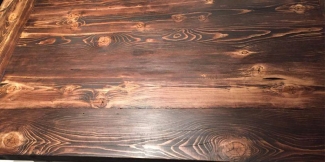

Dry time is the recommended length of time between coats of product, often called recoat time, and cure time is the length of time recommended before subjecting your finished project to daily use. The following factors can influence your dry time:
GF advises extra care and prep when applying any finish over laminate surfaces because they are specifically designed not to mar and therefore they are not very "sand-able", making adherence difficult.
In addition to this non-permeable surface factor, General Finishes Gel Stain is an oil-based product, and it is more difficult to obtain proper drying characteristics over a dense manufactured surface such as laminate. Gel stains, as all wood stains, were formulated to go over raw wood which has an "open" surface and can absorb some of the stain.
Our recommendation to fix white cabinets that have yellowed is to do a thorough sanding and precleaning and recoat with the following products:
Gel Stain can be mixed with up to 50% Liquid Oil Stain but be aware that this will thin the viscosity.
We recommend starting with 10% Liquid Oil Stain and testing to your satisfaction. Add more Liquid Stain as needed up to 50%. The mix will be thin and more translucent with less color saturation and intensity, but will not lose any of its properties for adhesion and curing.
If the finish feels cool to the touch, it's not ready. When you can sand it to a dry powder, it is ready for the next coat. Dry times will be longer if it is raining, cold, or humid. When in doubt, waiting longer is always better.
While Gel Stain can be applied over an existing finish, it was originally engineered for raw wood surfaces. We prefer applying the Gel Stain over a slip coat of mineral spirits instead of topcoat as shown in this video, "How to Apply Gel Stain to Raw Wood"

Pine is full of pitch (rosin or tar) and stain alone will never adhere to these areas. The knots are so dense and hard there is no grain to hold the stain in place
To fix, sand the table lightly with 120-grit sandpaper and restain the table. To improve adherence of the stain, mix 2 parts Gel Stain with one part Gel Satin Topcoat. Apply as many coats of the mix as needed to obtain the desired color, allowing 24-hour dry time between coats.
It is normal to see a bit of stain on the brush when applying the first coat of topcoat. Topcoats often pull a bit of color on the first pass, but good preparation will minimize this.
To prepare open grains woods such as raw Oak for a water-based stain, we recommend sanding with 180-grit followed by no more than 220-grit sandpaper.
Haze (the technical term is blush) is caused by too many coats applied too quickly. A recoat time of 12 hours is not enough dry time when applying over an EXISTING finish. To remove the blush or haze, you can either wipe the area with a strong solvent, like xylene or lacquer thinner, or you can try sanding out the haze and then reapply the topcoat.